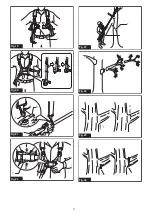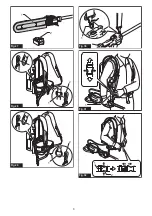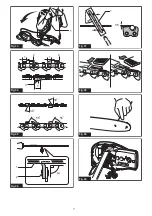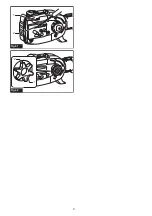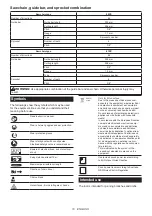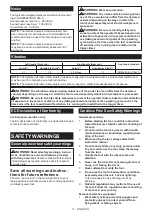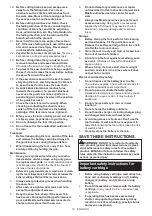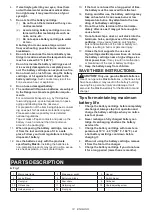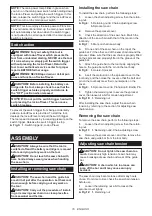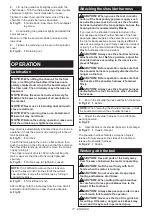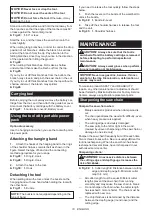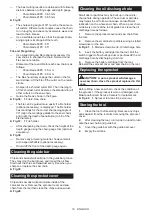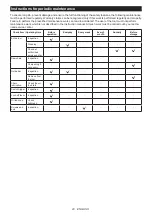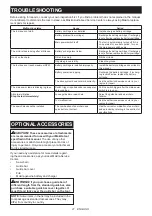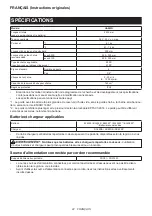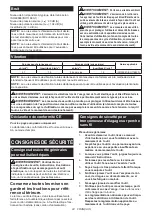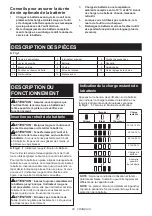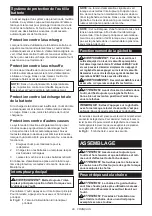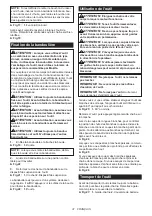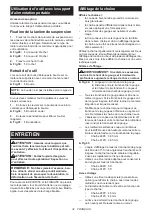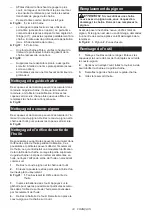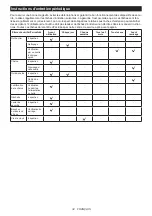
19 ENGLISH
— The best cutting results are obtained with following
distance between cutting edge and depth gauge.
•
Chain blade 90PX : 0.65 mm
•
Chain blade 91PX : 0.65 mm
►
Fig.35
— The sharpening angle of 30° must be the same on
all cutters. Different cutter angles cause the chain
to run roughly and unevenly, accelerate wear, and
lead to chain breaks.
— Use a suitable round file so that the proper sharp
-
ening angle is kept against the teeth.
•
Chain blade 90PX : 55°
•
Chain blade 91PX : 55°
File and file guiding
— Use a special round file (optional accessory) for
saw chains to sharpen the chain. Normal round
files are not suitable.
— Diameter of the round file for each saw chain is as
follows:
•
Chain blade 90PX : 4.5 mm
•
Chain blade 91PX : 4.0 mm
— The file should only engage the cutter on the for
-
ward stroke. Lift the file off the cutter on the return
stroke.
— Sharpen the shortest cutter first. Then the length
of this shortest cutter becomes the standard for all
other cutters on the saw chain.
— Guide the file as shown in the figure.
►
Fig.36:
1.
File
2.
Saw chain
— The file can be guided more easily if a file holder
(optional accessory) is employed. The file holder
has markings for the correct sharpening angle of
30° (align the markings parallel to the saw chain)
and limits the depth of penetration (to 4/5 of the
file diameter).
►
Fig.37:
1.
File holder
— After sharpening the chain, check the height of the
depth gauge using the chain gauge tool (optional
accessory).
►
Fig.38
— Remove any projecting material, however small,
with a special flat file (optional accessory).
— Round off the front of the depth gauge again.
Cleaning the guide bar
Chips and sawdust will build up in the guide bar groove.
They may clog the bar groove and impair the oil flow.
Clean out the chips and sawdust every time when you
sharpen or replace the saw chain.
►
Fig.39
Cleaning the sprocket cover
Chips and saw dust will accumulate inside of the
sprocket cover. Remove the sprocket cover and saw
chain from the tool then clean the chips and saw dust.
►
Fig.40
Cleaning the oil discharge hole
Small dust or particles may be built up in the oil dis-
charge hole during operation. These dust or particles
may impair the oil to flow and cause an insufficient
lubrication on the whole saw chain. When a poor chain
oil delivery occurs at the top of guide bar, clean the oil
discharge hole as follows.
1.
Remove the sprocket cover and saw chain from
the tool.
2.
Remove the small dust or particles using a slotted
screwdriver or the like.
►
Fig.41:
1.
Slotted screwdriver
2.
Oil discharge hole
3.
Insert the battery cartridge into the tool. Pull the
switch trigger to flow built-up dust or particles off the oil
discharge hole by discharging chain oil.
4.
Remove the battery cartridge from the tool.
Reinstall the sprocket cover and saw chain on the tool.
Replacing the sprocket
CAUTION:
A worn sprocket will damage a
new saw chain. Have the sprocket replaced in this
case.
Before fitting a new saw chain, check the condition of
the sprocket. If the sprocket is worn or damaged, ask
Makita Authorized Service Centers for replacement.
►
Fig.42:
1.
Sprocket
2.
Areas to be worn out
Storing the tool
1.
Clean the tool before storing. Remove any chips
and sawdust from the tool after removing the sprocket
cover.
2.
After cleaning the tool, run it under no load to lubri-
cate the saw chain and guide bar.
3.
Cover the guide bar with the guide bar cover.
4.
Empty the oil tank.
Summary of Contents for UA003GZ
Page 2: ...2 3 1 2 4 5 6 7 8 9 10 11 12 13 14 Fig 1 2 3 1 1 Fig 2 1 2 Fig 3 1 2 Fig 4 ...
Page 3: ...3 2 1 Fig 5 2 3 1 Fig 6 1 Fig 7 1 2 Fig 8 1 2 3 4 Fig 9 1 Fig 10 2 1 Fig 11 1 Fig 12 ...
Page 4: ...4 1 2 3 Fig 13 1 Fig 14 1 Fig 15 1 2 3 Fig 16 1 2 Fig 17 Fig 18 ...
Page 5: ...5 1 Fig 19 Fig 20 2 1 Fig 21 1 Fig 22 1 Fig 23 Fig 24 1 2 Fig 25 Fig 26 ...
Page 6: ...6 1 2 Fig 27 1 2 Fig 28 1 2 Fig 29 1 Fig 30 1 Fig 31 1 2 Fig 32 ...
Page 8: ...8 1 2 Fig 41 2 1 Fig 42 ...

